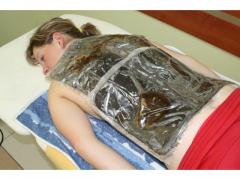
Mud
Treatment with mud has a long history. In German-speaking countries it is used since 1803. Russia followed.
In Poland, mud therapy has its traditions going back to the mid-nineteenth century. The effectiveness of natural mud in rheumatic diseases, inflammations of joints, disorders of blood flow, other symptoms of the bone and joint diseases as well as the ailments of digestive and urinogenital systems allowed this method to be added to the portfolio of therapeutic measures applied in medicine.
The difference between the mineral content of thermal waters and mud is, inter alia, that the a mud mass (except minerals) contains the mineralized parts of plants which had grown in areas of the Alpine region about 160 thousand years (mud bogs in Leopoldskron near Salzburg). At present, since decades mud exports from this area is carried out mainly to Great Britain, Italy, France and Germany.
Cataplasm of mud causes (depending on the surface on which it was applied, the time and temperature) local and often general warming or cooling the body. For therapeutic purposes the local and / or reflex effects are used. In the first place, the use of heat induce the characteristics of congestion, stimulates metabolism, easing muscles and soothing the pain. In the case of cold it causes the narrowing of blood vessels, inhibits the metabolism and gives the pain relief.
The mud proposed by us is applied in the form of hot and cold cataplasms.
1. APPLICATION:
Indications for the application of hot cataplasm:
- Subacute and chronic rheumatic conditions (inflammatory and degenerative diseases of joints and spine, rheumatic soft tissue changes )
- Post-traumatic states of the motion organs
- Functional disorders of blood flow
- Pain relief with chronic digestive and genitourinary diseases
Indications for the use of cold cataplasm:
- States of acute rheumatic diseases (inflammatory and degenerative changes in joints and spine, rheumatic soft tissue changes )
- Acute post-traumatic states of motion organs
- Assisting in the therapy of acute inflammations of the digestive complex
- Assisting in the therapy of thrombophlebitis
- Support for the fever reduction therapy
2. CONTRAINDICATIONS:
Heat:
- Acute inflammation, acute post-traumatic disorders;
- Bleeding, including menstruation bleeding and other bleeding from the respiratory and genital tracts (in interview), edema ;
- Abnormal blood supply to the skin caused by disease of small and large vessels, fever conditions;
- The surface of the skin with sensitivity disorders, damage to the skin in a large area diseases and acute skin diseases
- Vesicular changes (urticaria) caused by heat
Cold:
- Abnormal blood supply to the skin caused by disease of small and large blood and lymph vessels
- Vesicular changes caused by cold
- Occurrence of cryoglobulin in the blood
- Damage to the skin surface in a large area
3. Side effects:
It should be borne in mind that the treatments causing the overheating to a large area may induce the momentary imbalance when raising. Therefore, the patient should slowly change position from lying to the vertical. When applying hot cataplasm some congestion may occur causing irritation to the skin.
There is no impediment as to the effect on the ability to drive and use machines.